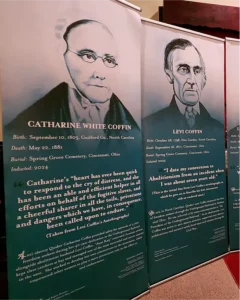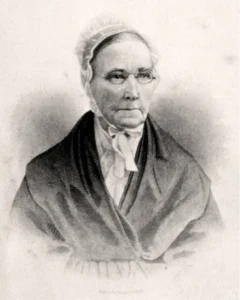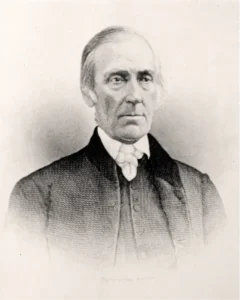Published October 22, 2024
Coffins Inducted into National Abolition Hall of Fame
Levi and Catharine Coffin, Quaker abolitionists who opened their homes in Indiana and Ohio to help more than 1,000 freedom-seekers on the Underground Railroad, have been inducted into the National Abolition Hall of Fame.
 Banners featuring the Coffins’ names and images were unveiled during a ceremony held Oct. 19 at the National Abolition Hall of Fame and Museum in Peterboro, N.Y. The Coffins will be permanently recognized there alongside past hall-of-fame inductees — among them Harriet Tubman, Frederick Douglass, Gerrit Smith and Sojourner Truth — as a testament to their enduring legacy of antislavery activism and the lasting impact of their work. Also included in the induction class of 2024 were Leonard Andrew Grimes and James McCune Smith.
Banners featuring the Coffins’ names and images were unveiled during a ceremony held Oct. 19 at the National Abolition Hall of Fame and Museum in Peterboro, N.Y. The Coffins will be permanently recognized there alongside past hall-of-fame inductees — among them Harriet Tubman, Frederick Douglass, Gerrit Smith and Sojourner Truth — as a testament to their enduring legacy of antislavery activism and the lasting impact of their work. Also included in the induction class of 2024 were Leonard Andrew Grimes and James McCune Smith.
Joanna Hahn, central regional director and site manager for the Levi and Catharine Coffin State Historic Site in Fountain City, wrote the hall-of-fame nominations for the Coffins. She emphasized Levi Coffin’s autobiography, “Reminiscences,” as a primary source detailing the couple’s decades of dedication before and during the Civil War, providing shelter, food and guidance to help freedom-seekers escape slavery.

Through Hahns’ research, she also found many contemporary accounts of people who worked alongside the Coffins — including several previous hall-of-fame inductees.
“It only seemed right to have the Coffins included in the National Abolition Hall of Fame along with other inductees they worked alongside to bring an end to slavery,” said Hahn. “This is an honor that extends beyond the historic site in Fountain City by celebrating their story on a national level.”
 Levi Coffin (1798-1877) committed his life to the eradication of slavery. A noted abolitionist in both Indiana and Ohio, he was heavily involved in many anti-slavery activities and societies. Through his tireless support, he gained the moniker of “President of the Underground Railroad.” Catharine White Coffin (1803-1881) focused her time and efforts on ending slavery as well as gaining rights for women. She was also honored on a Forever stamp unveiled in March by U.S. Postal Service.
Levi Coffin (1798-1877) committed his life to the eradication of slavery. A noted abolitionist in both Indiana and Ohio, he was heavily involved in many anti-slavery activities and societies. Through his tireless support, he gained the moniker of “President of the Underground Railroad.” Catharine White Coffin (1803-1881) focused her time and efforts on ending slavery as well as gaining rights for women. She was also honored on a Forever stamp unveiled in March by U.S. Postal Service.
Both born in North Carolina, the Quaker couple was married there in 1824 before moving to Indiana in 1826. The autobiography “Reminiscences” details harrowing accounts of how the Coffins repeatedly risked their lives to help freedom-seekers evade danger. The Coffins lived in Fountain City (then Newport) for 21 years, and their home was one of the most successful Underground Railroad depots in the United States, earning the title “the Grand Central Station of the Underground Railroad.” In 1847, the couple moved to Cincinnati, Ohio, where they continued their efforts until the end of the Civil War.
Their modest Indiana house is now the Levi and Catharine Coffin State Historic Site, part of the Indiana State Museum and Historic Sites museum system as well as a National Historic Landmark. The home is open to guided tours, where visitors can stand at Levi Coffin’s desk and peer inside a narrow second-floor cubby that once concealed freedom-seekers making their way north on the Underground Railroad.









